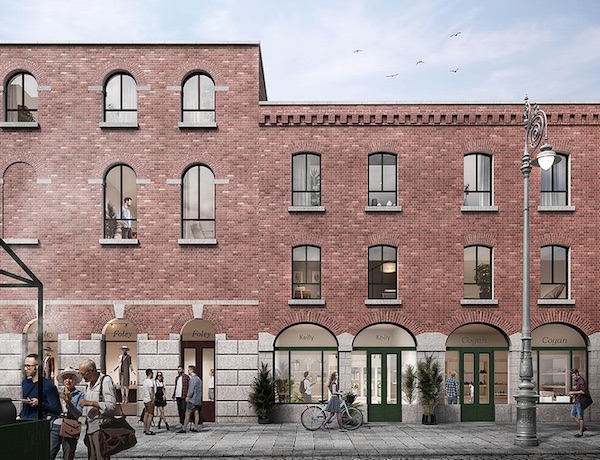
By Gerry Adams (for Leargas)
Most nations have buildings and landmarks which are important to them in their struggles for freedom and independence. Robben Island in South Africa held ANC prisoners for decades, including Mandela, Sisulu and others. It is now a World Heritage site. The Cu Chi tunnels in Vietnam are a network of interconnecting tunnels that stretch for 75 miles. Imagine someone deciding to abandon Robben Island or fill in the Cu Chi tunnels? Or if the government of India decided to concrete over the Jallianwala Bagh garden in Amritsar? Its the place where in 1919 the British Army massacred at least 379 unarmed civilians in an act of slaughter similar to our Bloody Sunday’s in 1920 and 1972.
Imagine the outrage if the government of the United States decided to demolish Independence Hall in Philadelphia and replace it with a Shopping Mall. It is the location of the second Continental Congress which met to sign the Declaration of Independence in 1776.
Every nation has these holy places where freedom was born or won.
We Irish are no different. Dublin’s GPO, Kilmainham, the H-Blocks and many more places dotted across this island tell the story of Ireland’s century’s long struggle for independence. The 1916 Easter Rising and its Proclamation of equality and justice inspired others to throw off the yoke of British colonialism.
Following six days of heroic resistance, the centre of Dublin lay in ruins. Five of the leaders of the Provisional Government met for the last time in 16 Moore Street and ordered the surrender. In 2005 the late Shane MacTomais – historian - wrote of those events:
“At eight o clock on Friday evening 28 April 1916, with the GPO engulfed in flames, the Provisional Government of the Irish Republic and IRA men and women retreated from the building and endeavoured to make their way to the Four Courts’ Garrison. They left the GPO by the side entrance in Henry Street and made their way under constant sniper fire to Moore Lane.
When they reached Moore Street they entered number five, Dunne’s Butchers, and immediately began tunneling from one house to another. The next morning, Saturday, they quickly realised that the wounded James Connolly, who had been placed on a panel door as a makeshift stretcher would not fit through the openings they had made. The men then placed Connolly in blankets and bundled him in great agony from house to house. When they reached number 16, Plunkets, a poultry shop, they placed him upstairs in the back room.
This small room, in a small house, in a small market street, in the heart of the capital city was to be the last place where the members of Provisional Irish Government held their council of war. Pádraig Mac Piarais, Joseph Plunkett, Tom Clarke and Seán Mac Diarmada all took their places around James Connolly and discussed what to do, while Elizabeth O’Farrell, Winifred Carney and Julie Grenan tended the wounded. The leaders decided that it was necessary to surrender to save further lives.”
This is Moore Street. It is part of the 1916 Battlefield site – the laneways of history. It has been described by the National Museum of Ireland as; ‘The most important site in modern Irish history.’ Today it is again a battlefield site. A major development company – with the support of past Irish governments – seeks to demolish much of these laneways to build a Shopping Mall. The four houses – 14-17 Moore Street – which are alone designated a national monument have been neglected and are in a poor state of repair.
The battlefield site encompasses the entire Moore St/O’Connell St. area. It stretches from Tom Clarke’s shop on Parnell Street; to the GPO; to Jenny Wyse Power’s home on Henry Street where the 1916 Proclamation was signed; to Moore Lane and Moore Street where the GPO Garrison retreated; to the spot where ‘The O’Rahilly’ died; to 16 Moore Street where five of the seven signatories of the Proclamation - Seán MacDiarmada, Pádraig Pearse, Joseph Plunkett, James Connolly and Tom Clarke - held their final meeting; to the Rotunda where the garrison was held by the British and where the volunteers had been founded three years earlier.
For over a decade a dedicated band of family members of the signatories - the Save 16 Moore Street Committee and the Families of the Signatories of the 1916 Proclamation - and their supporters have fought to protect Moore Street.
Last week the relatives published the first images of a regeneration plan for the area. The plan has been commissioned from a team of leading Irish architectural firms, planners and consultants. They believe that their plan “will not only reverse decades of official neglect but also act as a catalyst for the future regeneration of the city’s Northside. The plan also fully meets the recommendations of Minister Darragh O’Briens Advisory Group on the development of the Moore Street Battlefield as a historic cultural quarter.” This will also focus on the needs of local businesses and the Moore Street Traders.
The committee hopes to meet with Heritage Minister Darragh O’Brien in the coming weeks to discuss their proposal.
![[Irish Republican News]](https://republican-news.org/graphics/title_gifs/rn.gif)
![[Irish Republican News]](https://republican-news.org/graphics/title_gifs/harp.gif)

